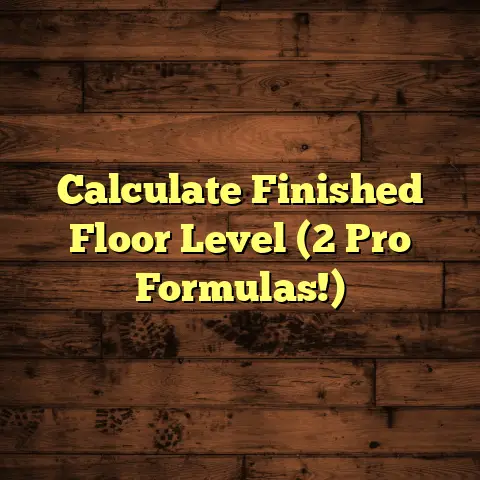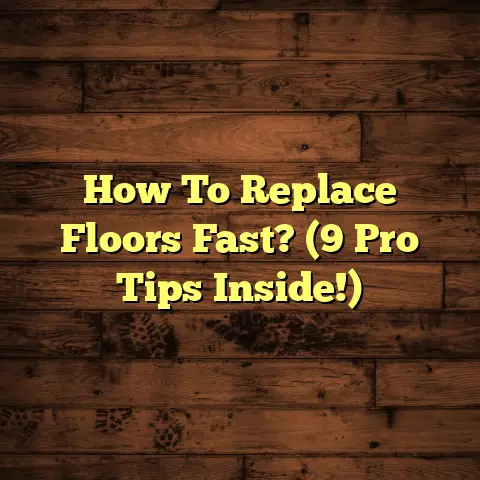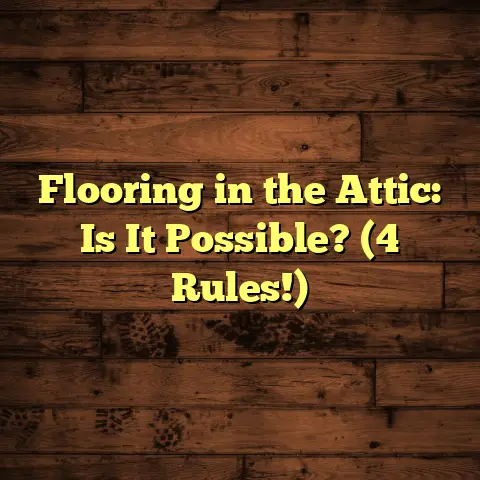What Does A Floor Joist Look Like?
Ever wonder what’s really holding up your floors?
It’s not magic, I can assure you.
As a flooring contractor with years under my belt, I’ve seen it all when it comes to what’s underneath your feet.
And trust me, what’s down there matters – a lot.
We’re talking about floor joists.
These unsung heroes are absolutely critical to your home’s structural integrity and, believe it or not, its resale value.
Yep, potential buyers do look at this stuff.
Think of it this way: A solid foundation and flooring system is like a good handshake.
It shows you care.
If the joists are rotting, sagging, or just plain neglected, it sends a loud message about the home’s overall maintenance history.
And that message can definitely impact what someone is willing to pay.
So, let’s dive in and explore the world of floor joists together.
I’ll break down what they are, what they look like, and why understanding them is crucial for any homeowner.
Ready? Let’s get started!
Section 1: Defining Floor Joists
Okay, so what exactly are floor joists?
In the simplest terms, they are horizontal structural members that support your floor.
They’re the “bones” of your flooring system, running parallel to each other and spaced at regular intervals.
Think of them as the framework that everything else – subfloor, underlayment, and your beautiful finished flooring – rests upon.
Their primary function is to distribute weight evenly across the foundation of your home.
Without them, your floors would sag, bounce, and eventually fail. Not a pretty picture, right?
Now, when it comes to materials, you’ve got a few options.
Most commonly, you’ll find floor joists made of wood.
This can range from traditional lumber like pine or fir to engineered wood products, which we’ll get into later.
However, in some commercial buildings or more modern homes, you might encounter steel joists.
Each material has its own strengths and weaknesses in terms of cost, strength, and ease of installation.
Section 2: The Anatomy of a Floor Joist
Alright, let’s get a little more technical and talk about what a floor joist actually looks like.
Typically, they’re rectangular in shape, although the exact dimensions can vary quite a bit depending on the span they need to cover and the load they need to support.
Common sizes you might see include:
- 2×8
- 2×10
- 2×12
(The first number is the thickness, and the second is the height, both in inches).
The spacing between joists is also critical.
You’ll often find them spaced 12, 16, or 24 inches apart, measured from center to center.
Again, the specific spacing depends on factors like the type of flooring being installed and the anticipated load.
Here’s a quick visual:
[Insert Image of Floor Joist Anatomy with Labels: Height, Thickness, Span, Spacing]
As you can see, it’s not just about the individual joist itself but also how they’re arranged within the overall flooring system.
You’ll typically find joists running perpendicular to the exterior walls, supported by beams or load-bearing walls.
Section 3: Types of Floor Joists
Now, let’s explore the different types of floor joists you might encounter.
This is where things get interesting!
Solid Wood Joists
These are your classic, traditional joists made from solid pieces of lumber.
Typical Species:
- Pine
- Fir
- Spruce
- Sometimes even hardwoods like oak
Dimensions: As mentioned earlier, 2×8, 2×10, and 2×12 are common.
Benefits:
- Relatively inexpensive
- Easy to work with
- Readily available
However, solid wood joists can be prone to warping, twisting, and splitting over time, especially if they’re not properly dried and seasoned.
Engineered Wood Joists
These are a more modern alternative to solid wood, offering improved strength and stability.
The most common types are:
- I-Joists: These have an “I” shaped cross-section, with flanges made of solid lumber or laminated veneer lumber (LVL) and a web made of oriented strand board (OSB).
- LVL (Laminated Veneer Lumber): Made by bonding thin wood veneers together under heat and pressure, creating a strong and consistent material.
Advantages:
- Greater strength and stiffness for a given size
- More consistent dimensions
- Less prone to warping and twisting
- Can span longer distances
Applications:
- New construction
- Remodeling projects where longer spans are needed
Steel Joists
These are typically used in commercial buildings or high-end modern homes.
Benefits:
- Incredibly strong and durable
- Resistant to fire, pests, and rot
- Can span very long distances
Limitations:
- More expensive than wood
- Require specialized tools and expertise to install
- Can be prone to corrosion if not properly protected
Here’s a quick comparison table:
| Type | Strength | Cost | Installation |
|---|---|---|---|
| Solid Wood | Moderate | Low | Easy |
| Engineered | High | Moderate | Moderate |
| Steel | Very High | High | Difficult |
Section 4: Visual Characteristics
of Floor Joists
So, how can you tell what kind of floor joists you have in your home?
Here are some visual clues to look for:
- Solid Wood: Look for the natural grain and knots of the wood. They’ll typically be rough-sawn and may have some imperfections.
- I-Joists: The distinctive “I” shape is a dead giveaway. You’ll also see the OSB web between the flanges.
- LVL: Look for the layered construction, with thin veneers glued together.
- Steel: Obviously, the material is the biggest clue here. They’ll typically be painted or coated to prevent rust.
What to Look For (Good):
- Straight, even joists with no signs of sagging or warping
- Proper spacing and alignment
- Solid connections to beams and foundation walls
- Dry, clean wood with no signs of rot or pest damage
What to Look For (Bad):
- Sagging: This indicates that the joists are undersized or overloaded.
- Cracking: Can be a sign of stress or damage.
- Rot: Soft, spongy wood is a sure sign of rot, often caused by moisture.
- Pest Infestation: Look for small holes, sawdust, or other signs of termites, carpenter ants, or other wood-boring insects.
If you spot any of these red flags, it’s time to call in a professional for a thorough inspection.
Section 5: Floor Joist Installation
and Support Systems
Okay, let’s talk about how floor joists are installed and supported.
The installation process typically involves:
- Layout: Determining the proper spacing and alignment of the joists.
- Cutting: Cutting the joists to the correct length.
- Placement: Positioning the joists between the foundation walls or beams.
- Fastening: Securing the joists to the walls or beams using nails, screws, or other fasteners.
Proper spacing and alignment are crucial for ensuring a safe and stable floor.
If the joists are too far apart, the floor will be bouncy and may even sag.
If they’re not properly aligned, the floor will be uneven and uncomfortable to walk on.
In addition to the joists themselves, you’ll also need support structures like beams, posts, and load-bearing walls.
These structures help to distribute the weight of the floor and the load it carries to the foundation.
Beams are typically larger horizontal members that run perpendicular to the joists, providing support at mid-span.
Posts are vertical supports that transfer the load from the beams to the foundation.
Section 6: Maintenance and Common
Issues with Floor Joists
Like any other part of your home, floor joists require regular maintenance to prevent problems.
Here are some common issues to watch out for:
- Rot: As mentioned earlier, moisture is the enemy of wood. Leaks, humidity, and poor ventilation can all lead to rot.
- Warping: Changes in humidity can cause wood to warp and twist, leading to uneven floors.
- Pest Damage: Termites, carpenter ants, and other wood-boring insects can wreak havoc on floor joists, weakening them and compromising their structural integrity.
Visual Identification:
- Rot: Look for soft, spongy wood that crumbles easily.
- Warping: Look for joists that are no longer straight or level.
- Pest Damage: Look for small holes, sawdust, or other signs of infestation.
Impact of Neglect:
If you neglect floor joist maintenance, the problems will only get worse over time.
Rot and pest damage can weaken the joists, leading to sagging floors, bouncy spots, and even structural failure.
This can not only be costly to repair but also dangerous for you and your family.
Section 7: Floor Joists and
Building Codes
Floor joists are subject to strict building codes and regulations that govern their installation and maintenance.
These codes are designed to ensure the safety and structural integrity of your home.
Key Considerations:
- Span Tables: These tables specify the maximum allowable span for different sizes and types of floor joists based on the anticipated load.
- Spacing Requirements: Codes dictate the maximum allowable spacing between joists.
- Fastening Requirements: Codes specify the type and spacing of fasteners used to secure the joists to the walls and beams.
Compliance and Resale Value:
Compliance with building codes is essential for both safety and resale value.
If your floor joists are not up to code, it can be a major red flag for potential buyers.
Hiring Professionals:
It’s always best to hire licensed professionals for floor joist inspections and repairs.
They have the knowledge and expertise to identify potential problems and ensure that the work is done safely and correctly.
Section 8: Conclusion
So, there you have it!
A comprehensive overview of what floor joists look like and why they matter.
Hopefully, this article has given you a better understanding of the backbone of your home’s flooring system.
Remember, understanding floor joists is crucial for maintaining your home’s structural integrity and protecting its resale value.
Be proactive about maintenance, keep an eye out for potential problems, and don’t hesitate to seek professional advice when needed.
By taking care of your floor joists, you’re taking care of your home!
Now, go forth and inspect your floors!
You might be surprised by what you find. And if you’re not sure what you’re looking at, don’t hesitate to call a professional. It’s always better to be safe than sorry.





